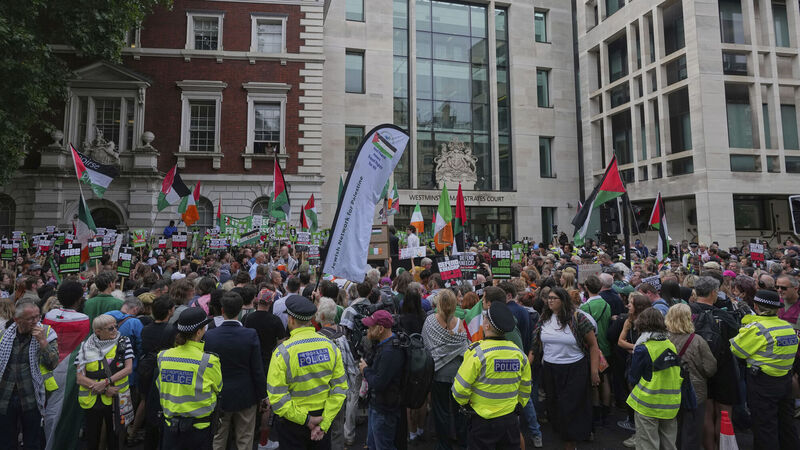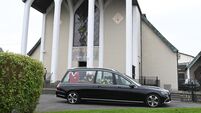Colin Sheridan: Irish language is back from the brink and shining on centre stage

Supporters of Liam Óg Ó hAnnaidh, aka Mo Chara, a member of the band Kneecap, wait with placards flags outside Westminster Magistrates Court in London where he is charged with a terrorism offence relating to displaying a flag in support of Hezbollah during a performance with the band in November 2024. Picture: AP
It's 14 years since Britain's Queen Elizabeth II rose to her feet in Dublin Castle and uttered the words “A Uachtaráin, agus a chairde.” To some, like then president Mary MacAleese, it was an incredible Wow moment. An act of reconciliation. To me, it was patronising and tokenistic. Much less an acknowledgement of our language and culture, much more a reassertion of an old order.
Conversely, the criminal case against Liam Óg Ó hAnnaidh — rapper, provocateur, and professional wielder of the fada — may be the most profound thing to happen to the Irish language since Peig got weaponised as a torture device. Forget Gaeltacht grants, forget TG4 documentaries about lads fixing fences on Inis Oir; this trial is what’s finally pushing Irish into the bloodstream of a generation.
Picture the courtroom. Barristers with powdered wigs sweating profusely as Ó hAnnaidh insists on responding only in Irish, his consonants cracking like a hurl on a shinbone. The judge, already bewildered by the very notion of the case, leans over to the clerk and whispers: “What the hell does amhrán graosta mean?” Outside, hordes of teenagers from Brixton chant “Ní sa chás cúirte atá an fíor-chinniúint — it’s in the beats, your honour!” in a bastard hybrid of Gaeilge and grime.
You couldn’t design a more effective state-funded ad campaign for the language if you paid Cillian Murphy to wear a “Tír gan teanga, tír gan Kneecap” T-shirt at the Oscars.
For decades, government attempts to revive Irish have resembled a committee of accountants trying to resuscitate a dead whale with a clipboard. Compulsory Irish in school turned the language into a bogeyman: an algebra of verbs, an Everest of irregular forms, a death march through 'An Spailpín Fánach' sung by teachers who had lost the will to live in 1973.
Money was poured into “initiatives” that have rushed to failure. Some civil servants once thought it a good idea to build Irish revival around dreary phrases like An bhfuil cead agam dul go dtí an leithreas? — a sentence useful only in primary school bathrooms or during hostage negotiations.
But Ó hAnnaidh’s case? That’s different. It’s raw. It’s political. It’s young people discovering that the language isn’t a mausoleum, but a crowbar. A weapon. A TikTok soundbite with legal implications.
And then, of course, there’s the English. And by the English, I don't mean those from Edgware Rd in London or Handsworth in Birmingham, places so rich in language they'd make Manchán Magan weep.
No, the other English, they’ll never, ever understand. They once banned us from speaking Irish, and yet they now scratch their heads in opinion pieces asking why the Irish don’t just “move on".
To them, Irish is a “nice cultural accent” — like Cornish. They will never grasp that Ó hAnnaidh standing in court demanding translation is not “obstructive behaviour” but rather the purest act of cultural vengeance since The Pogues rocked the Albert Hall.
When the English hear Irish rap, they don’t hear resistance. Their overly moisturised ears are too ignorant for that. For many (of the establishment class at least), the problem with Ireland is that it's full of Irish. A former colony, good for fishing, spoiled by fenian disobedience.
So, imagine, if you will, the eventual Netflix docuseries: . Episode three: Ó hAnnaidh, cross-examined, responds in verse, feat Lankum. The prosecution objects. The jury starts chanting. A mistrial is declared when the stenographer types “Tá muidne ar buile” and it goes viral.
The Irish government, panicking, commissions a think-tank called “Taskforce Gaeilge 2040.” Their report recommends more signage in bus stations and a pilot scheme where Leo Varadkar raps a cúpla focal at Electric Picnic. It fails miserably. Meanwhile, Ó hAnnaidh’s legal fees are crowdfunded entirely in Irish, confusing Revenue so much that the economy itself has to switch to bilingual accounting.
By 2030, every teenager is fluent, having learned more from Kneecap court transcripts than from 14 years of schooling.
That’s the thing: languages don’t survive through tidy plans, they survive through mess, scandal, and sheer audacity. Latin died because it behaved. Irish lives because it rebels.
Ó hAnnaidh in court, refusing to fold, refusing to sanitise, is exactly the absurd oxygen Irish has been gasping for. This isn’t heritage week in a parish hall. It’s not an earnest YouTube ad telling you “Is féidir linn” over stock footage of Connemara sunsets. This is the language dragging itself back onto the stage, bruised, hilarious, and alive.
And that’s why the English — who believe they invented irony — can never understand. They still think language is for order, for control, for queuing. Irish isn’t for queuing. Irish is for shouting across bogs, for naming saints and swears in the same breath, for defending yourself in a London courtroom while the Crown Prosecution Service tries not to cry.
So, let’s be clear: the criminal case against Liam Óg Ó hAnnaidh isn’t a scandal. It’s a syllabus. It’s the first real, national, compulsory course in modern Irish that anyone actually wants to take. Every sneer from the Crown, every mistranslation in court, every headline in the about “IRA rap group” is a free lesson.
Forget grants. Forget policies. The Irish language doesn’t need protection. It needs to embrace dissent. And in Liam Óg Ó hAnnaidh, it has found its perfect, chaotic professor.















